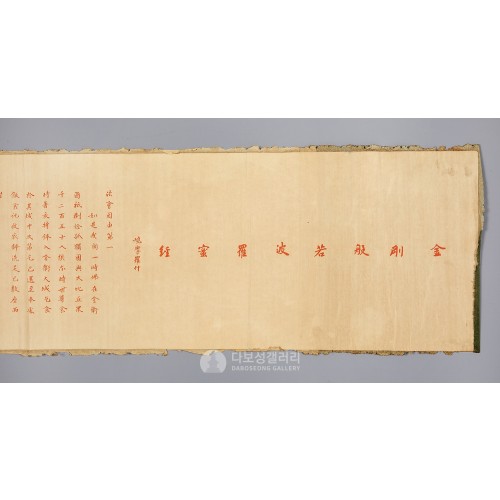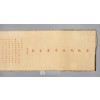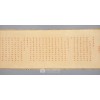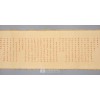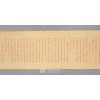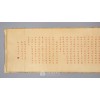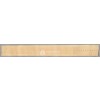본문
홍일법사가 금강반야바라밀경(金剛般若波羅蜜經)을 사경(寫經)한 유물입니다.
사경에 쓰인 재료는 주묵(朱墨)으로 추정됩니다.
붉은 먹인 주묵은 주사(朱砂)를 이용해 제작한 먹으로, 예로부터 붉은 색으로 글씨나 그림을 그리면 삿된 것을 쫓는 벽사(辟邪)의 효능이 있다고 여겨져 왔습니다.
▣ 금강반야바라밀경 (金剛般若波羅蜜經)
대한불교조계종의 소의경전(所依經典)입니다. 《금강반야바라밀경》, 《금강반야경》이라고 부르기도 합니다.
한 곳에 집착하여 머물러 있는 마음을 내지 말고, 모양이 없는 진리로서의 부처를 깨달아야 된다고 하였습니다.
한반도에 불교가 들어올 삼국시대 때부터 같이 들어온 서적이며, 따라서 한국에서 가장 널리 퍼진 대표적인 불경이기도 합니다.
▣ 쿠마라지바 (鳩摩羅什) (AD 344 - AD 413)
구자국(龜玆國: 현재의 신장 쿠차) 출신의 불교 사상가.
중국 후진(後秦) 시대 장안(長安)에 와서 약 300권의 불교 경전을 한자로 번역한 게 유명하며, 그의 불경 번역은 불교 보급에 공헌했을 뿐 아니라 삼론종(三論宗)・성실종(成実宗)의 기초가 되었습니다.
최초의 삼장법사(三藏法師)로 불리며, 훗날 현장(玄奘) 등 많은 삼장이 등장했습니다.
쿠마라지바는 현장과 함께 2대 대역성(大訳聖)으로 불리며, 또한 진제(真諦), 불공금강(不空金剛)과 함께 4대 역경가(訳経家)로 꼽습니다.
▣ 홍일법사 (弘一法師) (1880~1942)
1880년, 중국 톈진에서 관공서 일을 맡던 거상(鉅賈)의 집안에서 태어났습니다.
22세에 상하이 남양공학에 입학하였고, 26세에 일본으로 유학을 떠났으며, 32세에 중국으로 돌아와 톈진공업대학에서 교직을 맡았습니다.
1916년에는 항저우 서호에 있는 정혜사(虎跑定慧寺)에 들어갔고, 1918년(39세)에 출가하여 승려가 되었습니다.
법명은 인음(寅音), 법호는 홍일(弘一)이며, 속명은 이숙동(李叔同)으로 알려져 있습니다.
그는 중국에서 최초로 서양 회화를 도입한 인물이며, 처음으로 오선지를 사용해 음악 교육을 실시한 사람입니다.
또한, 중국 최초의 화극사를 설립하는 등 예술 분야에서 선구적인 역할을 했습니다. 음악, 서예, 회화, 희극 등 다양한 방면에 깊은 조예를 지녔으며, 생애 중 50년 이상을 서예와 함께했습니다.
현대 서예가들 중에서도 그만큼 열정적으로 서예의 길을 걸었던 이는 드물며, 말년에는 자신만의 독창적인 서체를 남겼습니다.
그의 작품은 중국 서예 예술사에서 탁월한 성과로 평가받고 있습니다.
그는 모든 사람에게 '홍일 스승'으로 알려졌으며, 1942년에 복건성 천주시에서 61세의 나이로 평화롭게 세상을 떠났습니다. 홍일법사는 청나라 말기의 3대 시적 스님(시승 詩僧, 시에 능한 승려) 중 한명입니다. (다른 사람들은 수만수, 시정간입니다)
━━━━━
这是弘一法师手写的《金刚般若波罗蜜经》作品。
据推测,书写所使用的墨水为朱墨。
朱墨是使用朱砂制作的红色墨水,古人认为用红色书写文字或画图具有驱邪辟恶的功效。
自古以来,僧人们非常重视用血液或朱墨抄写经文,并且他们致力于在最上等的纸张上用精准的笔法书写。
▣ 《金刚般若波罗蜜经》
是大乘佛教的经典之一,也是大韩佛教曹溪宗的主要经典。它也被称为《金刚般若经》或《金刚经》。
经文教导人们不要生起执着于某个地方或事物的心,而应领悟无形真理之佛的本质。
此经典自三国时代佛教传入朝鲜半岛时一同传入,因此成为韩国传播最广、最具代表性的佛教经典之一
▣ 鳩摩羅什 (AD 344 - AD 413)
龟兹国(现今新疆库车)出身的佛教思想家。
他在中国后秦时期来到长安,将300部佛教经典翻译为汉语,这些翻译不仅为佛教的传播作出了重要贡献,还奠定了三论宗与成实宗的基础。
他被称为最早的“三藏法师”,后来如玄奘等众多三藏相继出现。
鸠摩罗什(Kumārajīva)与玄奘并称为“二大译圣”,此外,他与真谛、不空金刚一起被列为“四大译经家”。
▣ 弘一法師 (1880~1942)
1880年出生于天津一官宦富商之家。
22岁时,他进入上海南洋公学学习,26岁时赴日本留学,32岁时回国并在天津工业大学任教。
1916年,他进入杭州西湖附近的虎跑寺,并于1918年(39岁)出家,成为一名僧侣。
法名演音,号弘一,俗名李叔同。
他是中国最早引入西洋绘画的人,也是首位使用五线谱进行音乐教学的人。
此外,他还在中国创办了第一所话剧学校等,成为艺术领域的开创者之一。
他在音乐、书法、绘画、戏剧等多个领域都有深厚的造诣,并且在生命中,有超过50年都在致力于书法。
即使在现代书法家中,像这样充满热情地走上书法之路的人也极为罕见,他在晚年创作了自己独特的书法风格。
他的作品被认为是中国书法艺术史上的杰出成就。
━━━━━
This is a transcription of the Diamond Prajnaparamita Sutra by Hong Yi Dharma Master.
The material used for the transcription is presumed to be red ink (朱墨).
Red ink, made from cinnabar (朱砂), has long been believed to have the power to ward off evil when used for writing or painting.
Since ancient times, monks have considered it highly significant to transcribe scriptures using blood or red ink (朱墨), striving to write with precise calligraphy on the finest paper.
▣ The Diamond Prajnaparamita Sutra (金剛般若波羅蜜經)
This is one of the classic scriptures of Mahayana Buddhism and serves as a foundational text for the Jogye Order of Korean Buddhism.
It is also referred to as the "Diamond Prajnaparamita Sutra" (金刚般若经) or simply the "Diamond Sutra" (金刚经).
The sutra teaches that one should not cling to any specific place or object but should realize the essence of the Buddha, which transcends form.
Since the introduction of Buddhism to the Korean Peninsula during the Three Kingdoms period, this sutra has been transmitted along with it.
As a result, it remains one of the most widely disseminated and representative Buddhist scriptures in Korea.
▣ Kumārajīva (AD 344 - AD 413)
A Buddhist thinker from the Kingdom of Kucha (龜兹國), now modern-day Kuqa in Xinjiang, China.
During the Later Qin period in China, he arrived in Chang’an and translated approximately 300 Buddhist scriptures into Chinese.
His translations not only contributed significantly to the spread of Buddhism but also laid the foundation for the Sanlun School (三論宗) and Chengshi School (成實宗).
He is regarded as the earliest "Tripitaka Master" (三藏法師), a title later held by many, including Xuanzang (玄奘).
Kumārajīva and Xuanzang are jointly honored as the "Two Great Translators" (二大译圣).
Additionally, he is counted among the "Four Great Translators of Buddhist Scriptures" (四大译经家) alongside Paramārtha (真諦) and Amoghavajra (不空金剛).
▣ Hong Yi Dharma Master (弘一法師) (1880~1942)
Hong Yi Dharma Master was born in 1880 into a wealthy merchant family engaged in government affairs in Tianjin, China.
At the age of 22, he entered Nanyang Public School in Shanghai.
At 26, he went to Japan for further studies, and at 32, he returned to China to take a teaching position at Tianjin Industrial University.
In 1916, he entered Dinghui Temple (虎跑定慧寺) at West Lake in Hangzhou.
In 1918, at the age of 39, he became a monk and was given the Dharma name Yin Yin (寅音), with the monastic title Hong Yi (弘一). His birth name was Li Shutong (李叔同).
He was the first person to introduce Western painting to China and the first to use staff notation in music education.
Additionally, he established the first modern Chinese drama society, making significant contributions to the arts.
He excelled in various fields, including music, calligraphy, painting, and theater. Throughout his life, he devoted more than 50 years to calligraphy.
Few modern calligraphers have pursued the art as diligently as he did.
In his later years, he developed a unique and original calligraphic style, which is regarded as an outstanding achievement in the history of Chinese calligraphy.
He was known to everyone as "Master Hong Yi" and peacefully passed away in 1942 in Quanzhou, Fujian Province, at the age of 61. Hong Yi Dharma Master is regarded as one of the three great poet-monks of the late Qing Dynasty. (The others are Su Manshu and Shi Jingan.)
